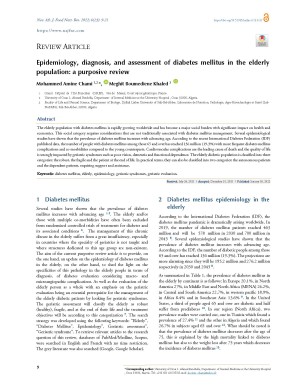Epidemiology, diagnosis, and assessment of diabetes mellitus in the elderly population: a purposive review
Abstract
The elderly population with diabetes mellitus is rapidly growing worldwide and has become a major social burden with significant impact on health and economics. This social category requires considerations that are not traditionally associated with diabetes mellitus management. Several epidemiological studies have shown that the prevalence of diabetes mellitus increases with advancing age. According to the recent International Diabetes Federation (IDF) published data, the number of people with diabetes mellitus among those 65 and over has reached 136 million (19.3%) with more frequent diabetes mellitus complications and co-morbidities compared to the young counterparts. Cardiovascular complications are the leading cause of death and the quality of life is strongly impacted by geriatric syndromes such as poor vision, dementia and functional dependence. The elderly diabetic population is classified into three categories; the robust, the fragile and the patient at the end of life. In practical terms, they can also be classified into two categories: the autonomous patients and the dependent patients, requiring support and assistance.
Full text article
Authors
Copyright (c) 2022 Mohammed Amine Chami, Meghit Boumediene Khaled

This work is licensed under a Creative Commons Attribution 4.0 International License.
-
Attribution — You must give appropriate credit, provide a link to the license, and indicate if changes were made. You may do so in any reasonable manner, but not in any way that suggests the licensor endorses you or your use.
-
No additional restrictions — You may not apply legal terms or technological measures that legally restrict others from doing anything the license permits.





